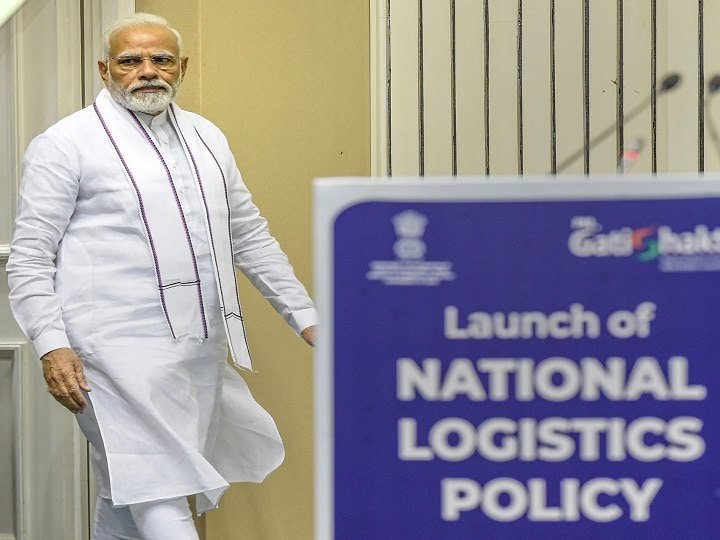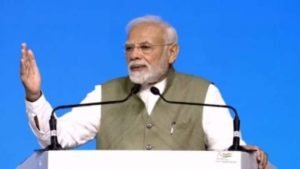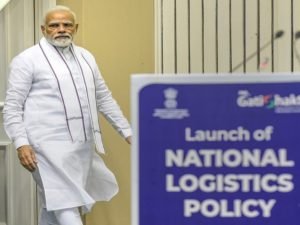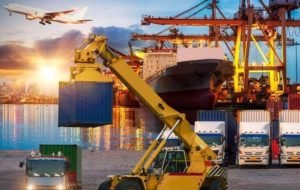India’s National Logistics Policy: How will it benefit, how Modi government is planning to accelerate the economy!


PM Narendra Modi launched the new National Logistics Policy on his birthday i.e. 17 September. On the special occasion of his birthday, he gave a big gift to the nation. This step of the government is being told as a big step towards accelerating the economy of developing India. Initiating this policy, the PM introduced the public to its merits and said in the address that this policy will give a new direction to India moving towards development. In the meantime, questions must be arising in the minds of the people regarding this new policy that how does this policy work and what will be its effect on the economy of the country?
Why do we need this policy ?
During the launch of the NLP, the Prime Minister said that in the last eight years, the government has been working towards improving connectivity through ‘Systemic Infrastructure Development’ with schemes like Sagarmala, Bharatmala, etc.. At present, road, water transport and air transport are used in this logistics process of bringing the goods needed by the countrymen from abroad and transporting them to the places where they are needed and the maximum expenditure in this is on fuel.
Apart from all this, if the goods are being transported by road, then there are many such expenses including toll tax, road tax, which is very costly in comparison to other countries. The new National Logistics Policy has been launched with the objective of reducing this cost and addressing all the challenges related to distribution-transportation of goods. Through the National Logistics Policy, the problems which were being faced in the supply of goods will be eliminated and would also benefit in the direction of reducing fuel consumption at the time of freight.
Talking about this policy in his address, Prime Minister Modi said that with the help of this policy, India’s economy will grow rapidly. He also enumerated its usefulness and merits. The PM said that this policy will give a new flight to self-reliant India from the lower level to the national level. Overall, the new National Logistics Policy has been started to give impetus to the economy of the country affected by Covid.

What is National Logistics Policy?
A single reference point has been made in the National Logistics Policy, whose objective is to bring down the cost of the logistics sector to 10 percent in the next 10 years, which is currently 13-14 percent of GDP. At present, most of the work of freight i.e., logistics is done through roads in India. Under this policy, the work of freight will now be done by rail transport as well as shipping and air transport. The biggest advantage of this will be that there will be less traffic on the roads and thus fuel expenditure would be shelved. It will take less money and time.
What is Logistics?
In fact, essential things are not available everywhere in remote villages or cities in India. From food and drink to diesel-petrol, from big to small goods, traders have to carry their goods, raw materials used in factories, essential fuel and all kinds of things from one place to another. Sometimes this distance is less while sometimes this distance is very long. A large network works behind this, which delivers things to the specified place on time. This is what is called freight transportation.
Many times these necessities include bringing goods from abroad and storing them, before sending them anywhere and then delivering the things where they are needed. Fuel is the constituent which is most expensive in this whole process. Apart from this, the distance in carrying goods by roads and delay in reaching the destination, toll tax and road tax etc., which are easier and less expensive in developed countries due to simpler method of logistics.


What are the goals under the policy?
The goal of this policy is to have higher logistics cost in India as compared to other developed economies. India’s logistics cost is considered to be around 13-14 percent as a ratio of GDP. The goal of the government is to bring it to single digits as soon as possible. Apart from this, the government is trying to make India one of the top 25 countries in the Global Logistics Performance Index Ranking by 2030. Currently, India was ranked 44th in the last edition of the list.
What did the Union Minister for Road Transport and Highways say?
Union Road Transport and Highways Minister Nitin Gadkari, while talking about this policy last Saturday, said that it is based on re-engineering, digitization and multimodal transport in India. This policy will help in ease of doing business for all industries and stakeholders. Gadkari said in one of his tweets, ‘National Logistics Policy will completely change the logistics sector of the country. Free movement of goods will be promoted and carbon emissions will come down.
He said that the central government has been working on this policy for the last three years. The commerce ministry issued a draft logistics policy for consultation in 2019, but it was delayed due to the COVID-19 pandemic. After this, once again in the budget of 2022-23, Finance Minister Nirmala Sitharaman announced the National Logistics Policy.
Speaking on this policy, Anshuman Singh, Chairman and Managing Director, Stellar Value Chain Solutions said that this policy issued by the PM reflects the positive intent of the government to address all the major challenges of the logistics and supply chain industry. He said that NLP sets the roadmap for developing a more interconnected and technology-driven framework for building cost and operating efficiency in the sector.
This policy will not only bring together all the logistics players and promote logistics competitiveness globally, but will also boost the confidence of investors who want to invest in the logistics sector.
Talking about the policy, Rizwan Somar, Chief Executive Officer and Managing Director, DP World Subcontinent said, “Multi-pronged Investing Approach adopted by the government in the policy to improve the basic infrastructure, services to attract investors will be done.”
What about Industrial Policy?
CII Director General Chandrajit Banerjee said in a statement that this policy, launched by the PM, will help in reducing the ease of doing business and transportation cost as per Indian industry. He said that lower shipping cost and increased logistic capacity will energize the economy in many ways and take us several steps forward to emerge as a global manufacturing powerhouse. ,
Jagnarayan Padmanabhan, Director and Practice Leader, Transport & Logistics, CRISIL, said that this is a holistic effort to enhance the efficiencies of all aspects of the logistics value chain. In the last five financial years, the government has invested around Rs 15 lakh crore in building tough infrastructure like roads, rail, ports and airports. If this policy is brought well, then the cost of supply to freight will also come down.
DISCLAIMER: The author is solely responsible for the views expressed in this article. The author carries the responsibility for citing and/or licensing of images utilized within the text.
